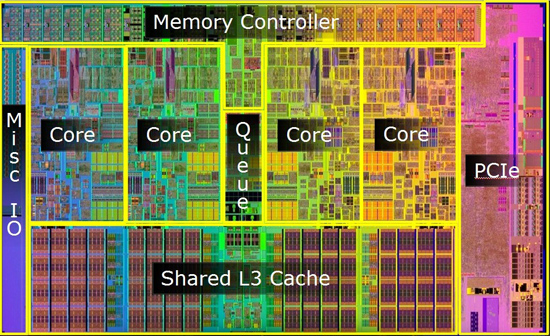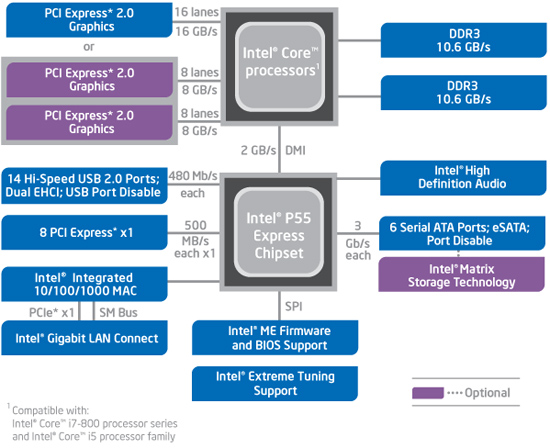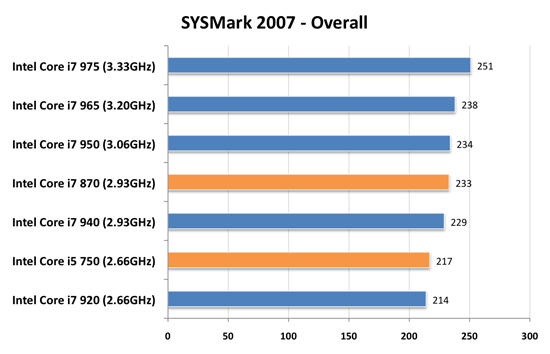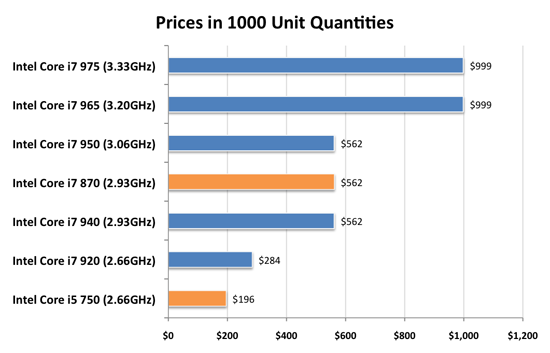Intel's Core i7 870 & i5 750, Lynnfield: Harder, Better, Faster Stronger
by Anand Lal Shimpi on September 8, 2009 12:00 AM EST- Posted in
- CPUs
Intel is on the verge of transitioning to 32nm. We'll see the first parts this year. What do you do with your 45nm fabs when you start moving volume away from them? Make really cheap quad-core Nehalems of course:

I'm talking $196. I'm talking faster than AMD's entire lineup. I'm talking about arguably the best processor of 2009. I'm talking about Lynnfield, and here's its backside:

Mmm
I spent much of the past year harping on AMD selling Nehalem-sized Phenom IIs for less than Intel sold Nehalems. With Lynnfield, Intel actually made Nehalem even bigger all while driving prices down. Like I said, what do you do when you're still making boatloads of money in a recession and are about to start emptying your 45nm fabs?
I should clear things up before we progress much further. Lynnfield is the codename for mainstream 45nm quad-core Nehalem, while Bloomfield refers to the first Nehalem launched at the end of 2008:
| Processor | Manufacturing Process | Die Size | Transistor Count | Socket |
| Bloomfield | 45nm | 263 mm2 | 731M | LGA-1366 |
| Lynnfield | 45nm | 296 mm2 | 774M | LGA-1156 |
Despite being cheaper, Lynnfield is larger than Bloomfield. The larger die is due to one major addition: an on-die PCIe controller.

Bloomfield, The First Nehalem, circa 2008

Lynnfield, Nehalem for All, circa 2009
The pink block to the right of the die is the PCIe controller, that's 16 PCIe 2.0 lanes coming right off the chip. Say hello to ultra low latency GPU communication. You'd think that Intel was about to enter the graphics market or something with a design like this.
Sacrifices were made to reduce CPU, socket and board complexity. Gone are the two QPI links that each provided 25.6GB/s of bandwidth to other CPUs or chips on the motherboard. We also lose one of the three 64-bit DDR3 memory channels, Lynnfield only has two like a normal processor (silly overachieving Bloomfield).

Intel's Bloomfield Platform (X58 + LGA-1366)
The sum is that Lynnfield is exclusively single-socket; there will be no LGA-1156 Skulltrail. While the dual-channel memory controller isn't really a limitation for quad-core parts, six and eight core designs may be better suited for LGA-1366.

Intel's Lynnfield Platform (P55 + LGA-1156)
The loss of QPI means that Lynnfield doesn't have a super fast connection to the rest of the system, but with an on-die PCIe controller it doesn't matter: the GPU is fed right off the CPU.
The Lineup
We get three Lynnfield CPUs today: the Core i7 870, Core i7 860 and the Core i5 750. Intel's branding folks told us that the naming would make sense one we saw the rest of the "Core" parts introduced; yeah that was pretty much a lie. At least there aren't any overlapping part numbers (e.g. Core i5 860 and Core i7 860).
The i7 in this case denotes four cores + Hyper Threading, the i5 means four cores but no Hyper Threading. The rules get more complicated as you bring notebooks into the fray but let's momentarily bask in marginal simplicity.
| Processor | Clock Speed | Cores / Threads | Maximum Single Core Turbo Frequency | TDP | Price |
| Intel Core i7-975 Extreme | 3.33GHz | 4 / 8 | 3.60GHz | 130W | $999 |
| Intel Core i7 965 Extreme | 3.20GHz | 4 / 8 | 3.46GHz | 130W | $999 |
| Intel Core i7 940 | 2.93GHz | 4 / 8 | 3.20GHz | 130W | $562 |
| Intel Core i7 920 | 2.66GHz | 4 / 8 | 2.93GHz | 130W | $284 |
| Intel Core i7 870 | 2.93GHz | 4 / 8 | 3.60GHz | 95W | $562 |
| Intel Core i7 860 | 2.80GHz | 4 / 8 | 3.46GHz | 95W | $284 |
| Intel Core i5 750 | 2.66GHz | 4 / 4 | 3.20GHz | 95W | $196 |
Keeping Hyper Threading off of the Core i5 is purely done to limit performance. There aren't any yield reasons why HT couldn't be enabled.
Intel was very careful with both pricing and performance of its Lynnfield processors. I'm going to go ahead and say it right now, there's no need for any LGA-1366 processors slower than a Core i7 965:

This is only one benchmark, but it's representative of what you're about to see. The Core i7 870 (LGA-1156) is as fast, if not faster, than every single LGA-1366 processor except for the ones that cost $999. Its pricing is competitive as well:

For $196 you're getting a processor that's faster than the Core i7 920. I'm not taking into account motherboard prices either, which are anywhere from $50 - $100 cheaper for LGA-1156 boards. I don't believe LGA-1366 is dead, but there's absolutely no reason to buy anything slower than a 965 if you're going that route.










343 Comments
View All Comments
7Enigma - Wednesday, September 9, 2009 - link
"What you are doing is cheating, and people is not stupid."Hand meet Face..... Gentleman we have a winner! Could you please post a picture of yourself so I can make a T-shirt?
james jwb - Tuesday, September 8, 2009 - link
i wouldn't go that far at all, but look a few comments above for my feelings on this. The honest way to go about this, Anand, was to do this review as you have done, but have a page or two dedicated to clock for clock, and to state in bold letter that turbo mode was on for the benches in the current review. Do this and all is forgivenHave you stopped to think how well Turbo mode in Lynfield has boosted benchmarks compared to bloomsfield?
As i said, yep, nice feature, but i do not expect a site to fall for stuff like this, i'd do stock (turbo-crap) results like you have, because this feature is there and cannot just be ignored, but my interest would have been to present clock for clock results on other pages, and it should have been yours as well. You've done a disservice to the enthusiast here. I was loving Lynnfield in your review until i realised turbo was on, then i felt this review was 100% useless to what i care and want to know about - clock for clock, and it must be the same for a huge percent of your readers, who at this stage, some probably haven't even realized turbo was on in your results and are still salivating. All enthusiasts who like to overclock themselves and not have turbo trying to trick us in reviews want clock for clock, you left them out, that is serious cause for questioning what the hell is going on at Anandtech. Sure, for those here who run stock, the review suffices, but, well, i've made my point now i think...
This is the first real blunder i've seen on this site, but imo its a big one, and that blogger who hates you guys and posts up lots of stuff about your contradictions (to which so far i find all his posts false, the server blog guy, you know who i mean), today he'll have a field day on this one.
Anand Lal Shimpi - Wednesday, September 9, 2009 - link
I can add a disclosure saying that turbo mode was enabled, but this has always been the case for our Nehalem reviews. We always try to review products with all of their features enabled as long as they ship that way and they don't reduce quality (e.g. certain GPU driver optimizations in the past).While I'll gladly add a clock for clock against Bloomfield in a few tests, flip back to our Lynnfield preview if you want a preview of that (that chip could only turbo up by 1 multiplier - effectively making it a clock-for-clock comparison to Bloomfield).
Turbo mode in Lynnfield does help it against Bloomfield in the lighter threaded apps, do keep in mind that Bloomfield has turbo as well.
It seems like what you're saying is that you want the maximum overclock possible for all cores and as such you will definitely disable turbo mode. In that configuration, the only difference between Lynnfield and Bloomfield (from a purely CPU standpoint) is one channel of memory. As I've mentioned before, that one memory channel is not going to make a tremendous difference for the vast majority of users. But if this is what you're asking for, I can definitely provide it. I'm out in California this week for an unrelated product, let me get back and I'll include that data in my Core i7 860 review.
Take care,
Anand
james jwb - Wednesday, September 9, 2009 - link
thanks for the response, it's appreciated. I hold anandtech on a pedestal, and was just surprised not to see some clock for clock stuff for the overclockers out there. I haven't used a CPU at stock for 6+ years for my main rig, so clock for clock is very important, though as you've said, there won't be too much difference between bloomsfield and lynnfield, i'd still like to see it, though :)As for your comment below about how intel and amd will be changing things soon for the stock users out there, well, i think clock for clock will become very important for overclocker then in these reviews, more so than ever to find out how each cpu performs, or maybe i'm wrong!
ClownPuncher - Tuesday, September 8, 2009 - link
Why would they turn off a product feature when reviewing said product? Because PhII doesn't have it? That is like not including DX10.1 results for AMD in HAWX. Consumers usually buy products based on features, this product has an aggressive turbo boost.Gary Key - Tuesday, September 8, 2009 - link
"there you go, finally you said it.all the benchmarks have at least 600 mhz over the processor's stock speed.
that is outrageous, then if you want to compare the result with phenom 2 you have to overclock phenom 2 at least 600 mhz over stock speed.
just to be fair "
First off, it is fair as that is how Intel ships the CPU, turbo is an integral part of the CPU's operation and is a major feature, end of subject.
Second, the 965 BE is not going to run stable at 4GHz under a 64-bit OS without near or sub-zero cooling. The Phenom IIs continue to have a problem when approaching 4GHz with a 64-bit OS. AMD has not fixed it yet.
james jwb - Tuesday, September 8, 2009 - link
Sorry, but i disagree. You seem to have swallowed some genious Intel marketing crap here. Yes, it's a nice feature, but any CPU can overclock, all overclockers will overclock, and your results gloss over that benchmarks were using turbo. This is bad, and the first time i've really seen this site do something really biased, or just stupid, not sure which...I'm telling you now, a big percentage of your readers will see the results for the 920 and 750 as clock for clock comparisons and think its a very close game here, and it's not.
I'll forgive you once you do a clock for clock comparison, but i won't forget that you pushed turbo results and nothing else, and didn't put a warning big bold statements like you normally do for important info stating these are with turbo on. Watch all excitement for this review from overclockers dwindle if you do.
goinginstyle - Tuesday, September 8, 2009 - link
They had an entire section discussing turbo mode, comments were made in the results about the turbo advantage,and their system setup page clearly states turbo in turned on for both lynnfield and bloomfield. Read the article.james jwb - Tuesday, September 8, 2009 - link
the look at turbo is rubbish, we need clock for clock against bloomsfield.It's not in bold, its of that importance to state this for those who flick through, which you'll find many do.
And still, i have no gripe with the data presented so far (aside from it not being very, very clear that turbo was on), my problem is what has been left out, and that is - a lot of important stuff for the enthusiast who control his own overclock.
goinginstyle - Wednesday, September 9, 2009 - link
Look on page 9 under the system setup, it clearly states that turbo is enabled. It is mentioned several times in regards to the performance results. If you could read, you would have understood that TURBO was ON. Several pages of the article discussed the new Turbo mode and how important it is to the performance of the processor.I suppose because you have labeled yourself an enthusiast that means you should be treated special. I guess between you, SnakeOil, TA152H, and a couple of others we could hold a special Olympics in your honor. Wouldn't that be special?
What is amazing, is that after reading several other reviews, it appears only Snakeoil at Tech Report is posting the same crap there as he did here. Everyone used Turbo mode in testing so why are you not posting at the other sites about how mistreated you are as an enthusiast.
Probably around 98% of computer owners do not overclock so why is it so hard to understand the testing methodology used here and elsewhere. For those of us that do not overclock, this article was perfectly suited for us and shows that we can get similar performance without opening up the box. Even for those who do overclock, they at least showed clock results and I am sure we will see more based on Anand's comments this morning.